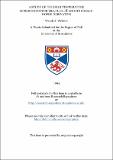Files in this item
A study of the high temperature superconductor YBa₂Cu₃O₇-𝛿 and its cobalt-doped derivative
Item metadata
| dc.contributor.advisor | Tunstall, D. P. (David Prestwich) | |
| dc.contributor.author | Webster, Wendy J. | |
| dc.coverage.spatial | 315 p. | en_US |
| dc.date.accessioned | 2018-06-27T13:01:59Z | |
| dc.date.available | 2018-06-27T13:01:59Z | |
| dc.date.issued | 1994 | |
| dc.identifier.uri | https://hdl.handle.net/10023/14659 | |
| dc.description.abstract | Static nuclear magnetic resonance (NMR) techniques have been used to study the magnetic hyperfine interactions of ⁶³Cu and ⁸⁹Y nuclei in the superconducting (T=1.5K) and normal (T=160-300K) states of the pure and cobalt doped Y-Ba-Cu-O layered cuprate systems. Sample quality and physical characteristics are well supported by magnetic susceptibility. Hall effect and X-ray diffraction measurements. We report ⁶³Cu NMR spin echo experiments, performed at 1.5K and 141MHz, on a uniaxially aligned sample of undoped YBa₂Cu₃O₇. By working at such low temperatures T, we provide clear confirmation that the spin components of the ⁶³Cu Knight shift, at both crystallographic sites and in all directions, vanish as T→0, leaving the orbital shift as the residual shift. This is indicative of singlet spin pairing in the superconducting state. The size and anisotropy of the ⁶³Cu(1,2) orbital shifts are consistent with a localised moment model in which there is a single hole of dₓ₂-[sub]y₂ (d[sub]y₂-[sub]z₂) symmetry in the d-shell shell of the Cu(2) (Cu(1)) ion. By working at high fields, where the demagnetisation corrections are much smaller, we are able to conclude that the disparity in the Kᶜorb(1,2) results from previous studies can be traced directly to discrepancies in the demagnetisation corrections, while inconsistencies in the Kᵃ, ᵇorb(1,2) components result from difficulties in analysing the restricted powder pattern. The effects of the atomic substitution of Co into the YBa₂(Cu₁-ₓMₓ)₃O₆.₉ (0≤x≤0.04) system have been investigated via an integrated ⁸⁹Y and ⁶³Cu NMR study on aligned powders. Combined susceptibility, X-ray and NMR measurements indicate that the Co ion substitutes preferentially at the Cu(1) site and bears a magnetic moment of around 3.7μB, consistent with a Co³⁺ localised moment of intermediate spin state (s=1). Theoretical modelling of the dipolar fields induced by such a moment suggest that the ⁸⁹Y and ⁶³Cu(2) NMR shifts and linewidths cannot be explained by a dipolar mechanism alone. The T[sub]c of the system is found to plateau at ~92K for x%<2.8, but then falls rapidly. This change in T[sub]c is found to coincide with a macroscopic orthorhombic (O) to tetragonal (T) structural transition at x=2.8%. The presence of a true O→T transition is also supported by changes in the ⁸⁹Y chemical shift. Falling hole concentration with increasing x indicates that T[sub]c is not determined by the planes hole concentration alone. Correlations between the ⁸⁹Y Knight shift and T[sub]c, and between ⁸⁹Y magnetic shifts for Co doped and oxygen depleted samples with the same T[sub]c, suggest that decreases in T[sub]c result from a reduction of the DOS at the Fermi level and that the mechanism responsible for T-dependent behaviour in both systems may be the same and directly related to T[sub]c. The complete devastation observed in the low temperature c//B ⁶³Cu(2) spectra for x%>0.5 is consistent with strong inhomogeneity in the Van Vleck component of the planes susceptibility. Finally, correlations between the ⁸⁹Y and ⁶³Cu(2) Knight shifts provide strong evidence in favour of a single quantum spin fluid. | en_US |
| dc.language.iso | en | en_US |
| dc.publisher | University of St Andrews | |
| dc.subject.lcc | QC611.6W3 | |
| dc.title | A study of the high temperature superconductor YBa₂Cu₃O₇-𝛿 and its cobalt-doped derivative | en_US |
| dc.type | Thesis | en_US |
| dc.contributor.sponsor | Science and Engineering Research Council (SERC) | en_US |
| dc.contributor.sponsor | University of St Andrews | en_US |
| dc.type.qualificationlevel | Doctoral | en_US |
| dc.type.qualificationname | PhD Doctor of Philosophy | en_US |
| dc.publisher.institution | The University of St Andrews | en_US |
This item appears in the following Collection(s)
Items in the St Andrews Research Repository are protected by copyright, with all rights reserved, unless otherwise indicated.

